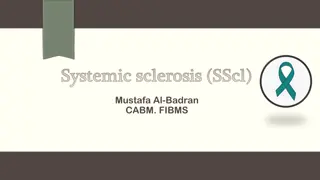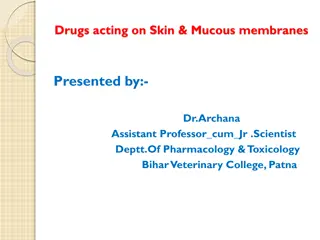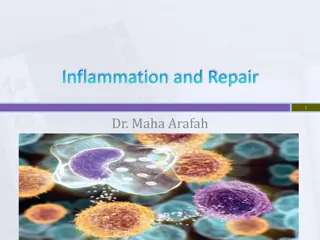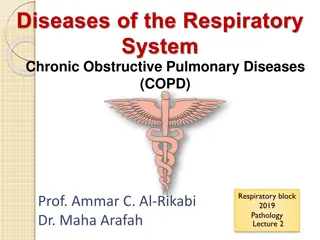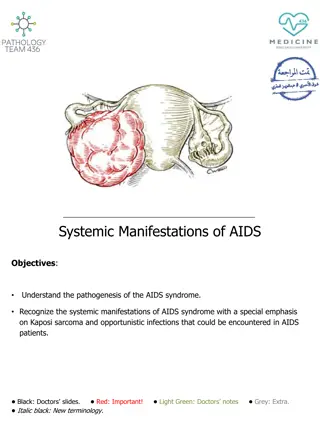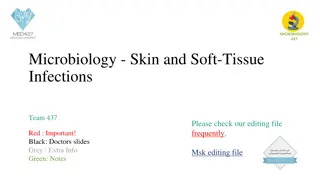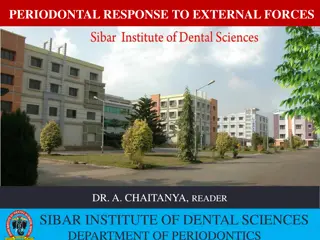Skin Manifestations of Connective Tissue Diseases - Lecture Highlights
This lecture series discusses the various skin manifestations of connective tissue diseases, focusing on Lupus Erythematosus and other related conditions. It covers different types of Lupus, its effects on the body systems, treatment options, and psychosocial impacts. Additionally, the presentation addresses the diagnosis and management of dermatomyositis, morphea, systemic sclerosis, and other conditions like Rheumatoid nodules. The content includes insights on Discoid Lupus Erythematosus and its typical features.
Download Presentation

Please find below an Image/Link to download the presentation.
The content on the website is provided AS IS for your information and personal use only. It may not be sold, licensed, or shared on other websites without obtaining consent from the author. Download presentation by click this link. If you encounter any issues during the download, it is possible that the publisher has removed the file from their server.
E N D
Presentation Transcript
Skin Manifestations of Connective Tissue Diseases Salim Alkeraye, MD Assistant Professor and Consultant Dermatology King Saud University
Objectives At the conclusion of these lectures the student will be able to: differentiate between the various types of Lupus recognize how Lupus affects the various systems of the body identify all of the current treatment options available for Lupus recognize the psychosocial effects that Lupus has on the patient and their family
Objectives To learn how to diagnose and investigate dermatomyositis. How to manage dermatomyositis. To learn the presentation of morphea and systemic sclerosis and ways to manage them. To recognize other diseases like Rheumatoid nodules and mixed CTD. This lecture is not meant to be inclusive of all the information about these diseases but to highlight important aspects in their diagnosis and management.
Lupus Erythematosus LE is as an autoimmune diseases associated with antibodies directed against components of cell nuclei. Lupus may affect any tissue, skin, kidneys, CNS, lungs and others.
LUPUS Discoid lupus erythematosus Subacute lupus erythematosus Neonatal lupus erythematosus Lupus tumidus Lupus profundus Chilblain lupus erythematosus Drug-induced lupus erythematosus Systemic Lupus Erythematosus
Discoid Lupus Erythematosus It is the commonest form of cutaneous lupus usually presents as red scaly patches or plaques that leave dyspigmentation and scarring mostly Hypopigmented or depigmented scars. It may be localized or widespread.
DLE Usually affects the cheeks, nose and ears, but sometimes involves the upper back, V of neck, and backs of hands. Involvement of hair follicles will lead to scarring alopecia 10% of DLE patients develop SLE.
Subacute lupus erythematosus Non-itchy dry rash appears on the upper back and chest, often following sun exposure. Subacute LE does not scar. Systemic involvement is not usually severe. Annular or polycyclic (ring-shaped) or as papulosquamous (scaly patches and plaques)
Neonatal lupus erythematosus Newborn babies born to mothers with subacute LE may develop annular rash, that resolve spontaneously. The neonates could be at risk of complete heart block.
Lupus Tumidus Dermal form of lupus. The rash is characteristically photosensitive, so it affects sun-exposed sites. Red, swollen, urticaria-like bumps and patches or swelling.
Lupus Profundus lupus affecting the fat underlying skin lupus panniculitis. it may develop at any age, including children. The face is the most common area to be affected.
Lupus Profundus Inflammation of the fat results in firm deep nodules for some months. The end result is deep scars on fat layer or lipodystrophy.
Chilblain Lupus Erythematosus Itchy and/or tender red or purple bumps that usually come on from cold exposure but can sometimes be precipitated by sun exposure or smoking. They are considered to be a form of skin vasculitis (blood vessel inflammation). Usually they have no circulating antibodies. And the main treatment is to avoid precipitating factors.
Drug-Induced Lupus Erythematosus Drug induced lupus does not usually affect the skin. The most frequent drugs are: Hydralazine , Carbamazepine , Lithium , Phenytoin , Sulphonamides , Minocycline.
Systemic Lupus Erythematosus Only a few patients with cutaneous LE also have SLE. The most common presentation is with a malar eruption or butterfly.
SLE Other skin changes in SLE are photosensitivity, mouth ulcers, and diffuse hair loss. SLE may also affect joints, kidneys, lungs, heart, liver, brain, blood vessels and blood cells
Investigations SLE is always with positive ANA. antiRo/La antibodies, is nearly always present in patients with subacute LE. Leucopenia tends to be more pronounced in patients with systemic LE
LUPUS Skin biopsy may be diagnostic especially in discoid lupus erythematosus. Direct immunofluorescence tests may show positive antibody deposition along the basement membrane (lupus band test).
Treatment of Cutaneous Lupus Erythematosus The aim of treatment for cutaneous LE is to alleviate symptoms and to prevent scarring. Smoking phenomena and chilblain lupus . cessation will help Raynaud's Sun protection.
Treatment Potent topical steroids, Intra lesional steroids. Oral antimalarial drugs. Oral steroids. Methotrexate, azathioprin, mycophenolate mofetil, cyclosporine, IVIG, and Rituximab. cyclophosphamide,
Dermatomyositis An uncommon inflammatory disease affects adults between 40-60 (females mainly) and children 5-15. Skin changes. A violet-colored or dusky red rash on face and eyelids and on areas around nails, knuckles, elbows, knees, chest and back. The rash, which can be patchy with bluish-purple discolorations, is often the first sign of dermatomyositis.
DM Heliotrope rash : a violaceous -to-dusky erythematous rash with or without edema in a symmetrical distribution involving periorbital skin.
Muscle weakness. Progressive proximal muscle weakness involves the hips, thighs, shoulders, upper arms and neck. The weakness is symmetrical and more in the extensor muscles.
Dermatomyositis Other signs and symptoms include: Photosensitivity Raynaud's phenomenon Dysphagia, gastrointestinal ulcers Muscle pain or tenderness Fatigue, fever and weight loss Calcinosis cutis especially in children Interstitial lung disease.
Dermatomyositis It can be associated with: Other connective tissue diseases such as lupus, rheumatoid arthritis, scleroderma and Sjogren's syndrome. Cancer, Especially in older patients, particularly of the cervix, lungs, pancreas, breasts, ovaries and gastrointestinal tract. Cancer could precede, coincide or follow the diagnosis of DM.
Investigations Magnetic resonance imaging (MRI). Electromyography. Muscle biopsy. Blood tests: creatine kinase (CK) and aldolase. Increased CK and aldolase levels can indicate muscle damage and CK is useful to monitor the treatment of DM. autoantibodies Skin biopsy is suggestive but not diagnostic that shows interface dermatitis.
Treatment Oral steroids are the mainstay treatment. Steroid sparing agents are: Methotrexate, azathioprin, mycophenolate mofetil, cyclosporine, cyclophosphamide, IVIG, and Rituximab. Topical steroids and antimalarial medications are used to improve the cutaneous rashes.
Treatment Physiotherapy to improve strength and flexibility of the muscles. Surgical excision or Co2 laser could be utilized to remove tender calcium deposits .
Scleroderma A group of rare diseases that involve the hardening and tightening of the skin and connective tissues Scleroderma affects women more often than men and most commonly occurs between the ages of 30 and 50.














